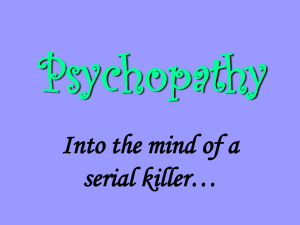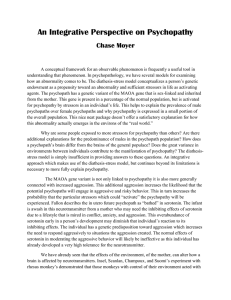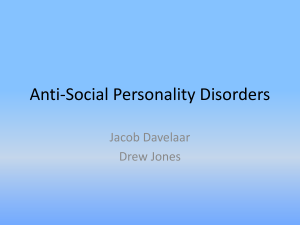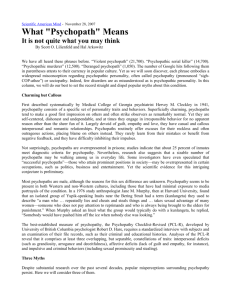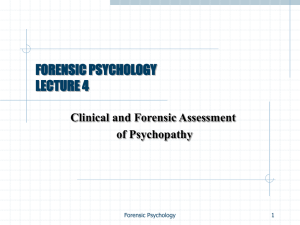Understanding Evil Emma Johnson ENGL 102 Dan Anderson
advertisement
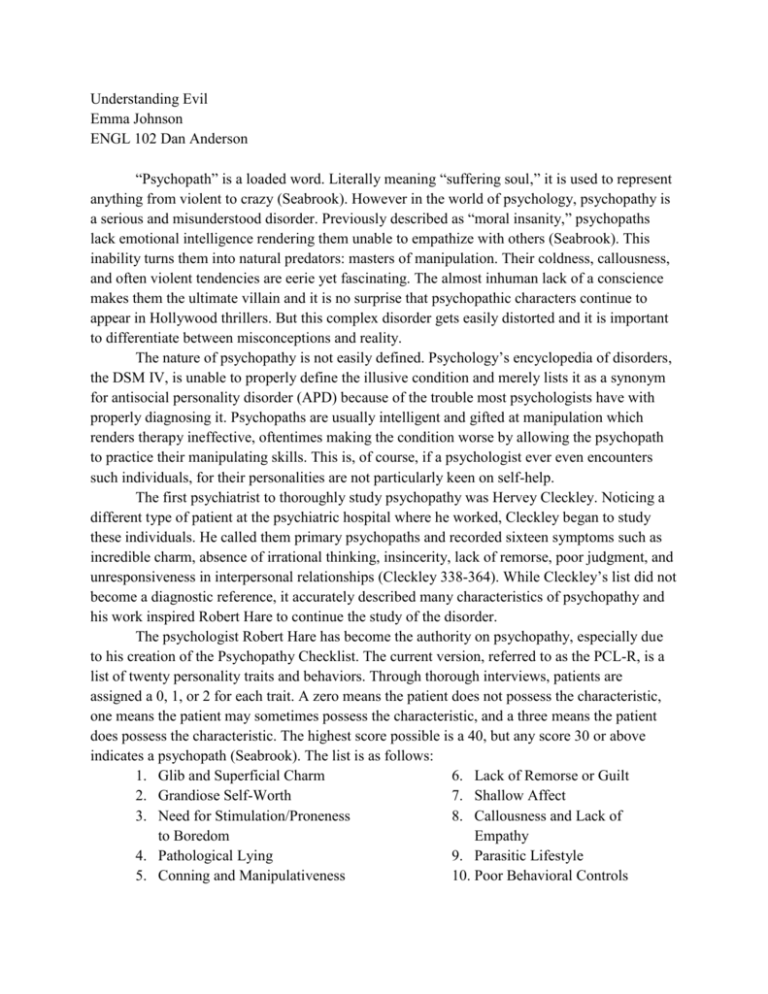
Understanding Evil Emma Johnson ENGL 102 Dan Anderson “Psychopath” is a loaded word. Literally meaning “suffering soul,” it is used to represent anything from violent to crazy (Seabrook). However in the world of psychology, psychopathy is a serious and misunderstood disorder. Previously described as “moral insanity,” psychopaths lack emotional intelligence rendering them unable to empathize with others (Seabrook). This inability turns them into natural predators: masters of manipulation. Their coldness, callousness, and often violent tendencies are eerie yet fascinating. The almost inhuman lack of a conscience makes them the ultimate villain and it is no surprise that psychopathic characters continue to appear in Hollywood thrillers. But this complex disorder gets easily distorted and it is important to differentiate between misconceptions and reality. The nature of psychopathy is not easily defined. Psychology’s encyclopedia of disorders, the DSM IV, is unable to properly define the illusive condition and merely lists it as a synonym for antisocial personality disorder (APD) because of the trouble most psychologists have with properly diagnosing it. Psychopaths are usually intelligent and gifted at manipulation which renders therapy ineffective, oftentimes making the condition worse by allowing the psychopath to practice their manipulating skills. This is, of course, if a psychologist ever even encounters such individuals, for their personalities are not particularly keen on self-help. The first psychiatrist to thoroughly study psychopathy was Hervey Cleckley. Noticing a different type of patient at the psychiatric hospital where he worked, Cleckley began to study these individuals. He called them primary psychopaths and recorded sixteen symptoms such as incredible charm, absence of irrational thinking, insincerity, lack of remorse, poor judgment, and unresponsiveness in interpersonal relationships (Cleckley 338-364). While Cleckley’s list did not become a diagnostic reference, it accurately described many characteristics of psychopathy and his work inspired Robert Hare to continue the study of the disorder. The psychologist Robert Hare has become the authority on psychopathy, especially due to his creation of the Psychopathy Checklist. The current version, referred to as the PCL-R, is a list of twenty personality traits and behaviors. Through thorough interviews, patients are assigned a 0, 1, or 2 for each trait. A zero means the patient does not possess the characteristic, one means the patient may sometimes possess the characteristic, and a three means the patient does possess the characteristic. The highest score possible is a 40, but any score 30 or above indicates a psychopath (Seabrook). The list is as follows: 1. Glib and Superficial Charm 6. Lack of Remorse or Guilt 2. Grandiose Self-Worth 7. Shallow Affect 3. Need for Stimulation/Proneness 8. Callousness and Lack of to Boredom Empathy 4. Pathological Lying 9. Parasitic Lifestyle 5. Conning and Manipulativeness 10. Poor Behavioral Controls 11. Promiscuous Sexual Behavior 17. Many Short-term Marital 12. Early Behavioral Problems Relationships 13. Lack of Realistic, Long-term 18. Juvenile Delinquency Goals 19. Revocation of Condition Release 14. Impulsivity 20. Criminal Versatility 15. Irresponsibility (Hare, Hart, and Harper 1991) 16. Failure to Accept Responsibility for own Actions Traits 1-8 are Factor 1 and traits 9-20 are Factor 2. Hare specifies that Factor 1 “reflects core interpersonal and affective characteristics” and Factor 2 “consists of items that reflect a socially deviant and nomadic lifestyle” (Hare 1996). The combination of these factors is what differentiates a psychopath from someone with APD. An individual with APD will meet many of the criteria in Factor 2 but not Factor 1. Hare compares the confusion between psychopathy and APD to “having pneumonia versus having a cold. They share some common symptoms, but one is much more virulent” (Seabrook). It is important to understand that psychopathy is not interchangeable with ADP and sociopathy, just as it is not a casual term for whoever we may find cruel, crazy, or violent. The liberal use of the term psychopath, and therefore the misunderstanding of its definition, is partially a product of Hollywood. From the cool and conscienceless gangster to the plotting and manipulative businessman, as well as the terrifying and chaotic serial killer, Hollywood loves psychopaths. Unfortunately, reality gets lost in translation occasionally and characters on screen can greatly misrepresent the nature of psychopathy. Psycho is an Alfred Hitchcock classic but the movie’s title is misleading. Without even evaluating whether or not the killer, Norman Bates, fits the criteria within the PCL-R, it is clear that Bates is suffering from dissociative identity disorder (DID), or multiple personality disorder. DID usually appears when the mind cannot handle a traumatic event, in this case when Bates killed his mother. His disorder developed out of guilt and remorse, two emotions psychopaths do not possess. While it is arguable Bates’ alternate personality has a disorder herself, there is insufficient evidence as to what that may be. Psychopathy as a condition is rarely combined with other mental disorders beyond substance abuse and narcissistic personality disorder. Another popular mistaken identity is The Shining. Despite frequently appearing on amateur ‘top-ten psychopaths in film’ lists, the character Jack Torrance is not a psychopath. Psychopathic personalities are present in an individual from an early age and do not just appear later in life as Torrance’s ailment did. Schizophrenia, however, does. It would also explain the delusions and hallucinations Torrance experienced that caused him to break down and become violent. Again, it is important not to confuse one psychological condition for another. However, the title character on the popular Showtime series Dexter may meet the criteria for psychopathy. He experiences the shallow affect, where one’s emotions are stunted. He also frequently references a dark passenger, the side of himself he hides that drives him to kill other people. The PLC-R will give a more definitive evaluation. Using Robert Hare’s scoring method, here are the estimated results:(Disclaimer: I am not trained to give the PCL-R. I am merely using my knowledge of the characters and Dr. Hare’s writings. Traits marked with NA do not apply to the character or there is not sufficient evidence to answer. Those points will be discounted from the full 40 points.) Glib/superficial charm 1 Promiscuity 0 Grandiose sense of self-worth 1 Early behavior problems 1 Need for stimulation/proneness to 1 Lack of realistic, long-term goals 0 boredom Pathological lying 1 Impulsivity 1 Conning/Manipulative 1 Irresponsibility 1 Lack of remorse or guilt 1 Failure to accept responsibility for actions 1 Shallow affect 2 Many short-term marital relationships 0 Callous/lack of empathy 1 Juvenile delinquency 2 Parasitic lifestyle 0 Revocation of conditional release NA Poor behavioral controls 1 Criminal versatility 1 Total: 17/38 Minimum score needed for positive result: 28 While Dexter may experience a few psychopathic tendencies, he is not necessarily a psychopath. Besides his shallow affect and affinity for violence, he does not have the large emotional deficit initially thought. Dexter may be a loner, but he has been in a relatively successful four-year relationship, he is good with children, he maintains friendships and family connections, he holds down a steady job, and he has a moral code, though unorthodox. Dexter’s actual ailment is unclear, though it seems to stem from witnessing his mother’s murder when he was a child. Beyond that, his condition is uncertain. Images of “crazy” people and incorrect uses of psychology terms have been perpetuated by these past works. However, there are more accurate portrayals of psychopathy within film and television that are still well-known. Possibly the most famous psychopath in film is Hannibal Lecter in Silence of the Lambs. Lecter is brilliant, eloquent, manipulative, pathological, and sadistic: the ideal psychopathic villain. Here are his results for the PCL-R: Glib/superficial charm 2 Promiscuity 0 Grandiose sense of self-worth 2 Early behavior problems 2 Need for stimulation/proneness to 1 Lack of realistic, long-term goals 0 boredom Pathological lying 2 Impulsivity 2 Conning/Manipulative 2 Irresponsibility 0 Lack of remorse or guilt 2 Failure to accept responsibility for actions 1 Shallow affect 2 Many short-term marital relationships 0 Callous/lack of empathy 2 Juvenile delinquency 2 Parasitic lifestyle 0 Revocation of conditional release NA Poor behavioral controls 1 Criminal versatility 2 Total: 25/38 Minimum score needed for positive result: 28 Hannibal Lecter is Hollywood’s perfect psychopath. All the personality traits the audience would want are there, but none of the messiness that is the reality of the disorder. Lecter cannot control his sadism, and yet he keeps his sexual desires, if any, completely in check. He had a good job that he was successful at and has never been dependent on anybody. He becomes a super villain; an evil genius with no weaknesses. But in complete contrast with Lecter, there is Buffalo Bill. He is obsessed with sexuality and appearance, he is very bazaar and awkward, and he lacks intelligence and maturity. Yet, he is the real psychopath. Glib/superficial charm 0 Promiscuity 1 Grandiose sense of self-worth 0 Early behavior problems NA Need for stimulation/proneness to 2 Lack of realistic, long-term goals 2 boredom Pathological lying 2 Impulsivity 2 Conning/Manipulative 2 Irresponsibility 1 Lack of remorse or guilt 2 Failure to accept responsibility for actions 2 Shallow affect 2 Many short-term marital relationships 1 Callous/lack of empathy 2 Juvenile delinquency NA Parasitic lifestyle 1 Revocation of conditional release NA Poor behavioral controls 2 Criminal versatility 2 Total: 26/34 Minimum score needed for positive result: 24 Buffalo Bill is the opposite of Lecter as far as serial killers go, but he is certainly a psychopath. American Psycho is about a man named Patrick Bateman who works some nondescript, high-powered job finance job. He is wealthy, good-looking, and has all the right connections. He is also psychopath. Glib/superficial charm 2 Promiscuity 2 Grandiose sense of self-worth 2 Early behavior problems NA Need for stimulation/proneness to 2 Lack of realistic, long-term goals 1 boredom Pathological lying 2 Impulsivity 2 Conning/Manipulative 2 Irresponsibility 1 Lack of remorse or guilt 2 Failure to accept responsibility for actions 2 Shallow affect 2 Many short-term marital relationships 2 Callous/lack of empathy 2 Juvenile delinquency NA Parasitic lifestyle 0 Revocation of conditional release NA Poor behavioral controls 2 Criminal versatility 2 Total: 30/34 Minimum score needed for positive result: 24 Bateman is charming, but enjoys tossing murderous comments into everyday conversation. He is extremely narcissistic; watching himself pose and flex in the mirror during sex. He says the only emotions he feels are greed and disgust. He is manipulative and pathological as he calmly has a conversation with someone about music while he prepares to shoot a nail gun through their skull. He is dangerously impulsive: he attempted to strangle someone because their business card was nicer than his and killed several people in about five minutes all because a woman saw him trying to kill a cat. He is also extremely successful and gets away with all his crimes. His ruthlessness, charm, and lack of a conscience make him a perfect businessman in American culture. The final accurate depiction of psychopathy in film also uses their natural predatory instincts to get ahead in the work place. The popular television series House featured a patient named Valerie during its sixth season. While trying to diagnose her, one of the doctors asked Valerie to talk about all the things she loves during an fMRI scan. The image showed that Valerie was using her language center instead of her limbic region (area that processes emotions) to describe her favorite moments. Robert Hare has commented on this phenomenon that, “It was as if they could only understand emotions linguistically. They knew the words but not the music, so to speak.” (Seabrook) Valerie was discovered as a psychopath. Here is her PCL-R: Glib/superficial charm 2 Promiscuity 2 Grandiose sense of self-worth 2 Early behavior problems 0 Need for stimulation/proneness to 1 Lack of realistic, long-term goals 0 boredom Pathological lying 2 Impulsivity 2 Conning/Manipulative 2 Irresponsibility 1 Lack of remorse or guilt 2 Failure to accept responsibility for actions 2 Shallow affect 2 Many short-term marital relationships 1 Callous/lack of empathy 2 Juvenile delinquency 2 Parasitic lifestyle 2 Revocation of conditional release NA Poor behavioral controls 1 Criminal versatility NA Total: 28/36 Minimum score needed for positive result: 26 Valerie scores high on the PCL-R, especially in Factor 1. She is extremely manipulative, pathological, callous, numb, and promiscuous. She sleeps with her coworker to steal his ideas then drugs him to get him fired. She makes up incredible lies on the spot to her husband and is only married for personal gain. She threatens and bullies her doctor until they cry and then says what a neat trick that is, that she could never do that. Valerie may be the only psychopath listed that is not violent, but she still poses a threat to those around her. Psychopaths in the work place can be just as dangerous as those in jail. Robert Hare brings up this point, “Can you say Ted Bundy caused more disaster than the guys at Enron? How many destroyed lives and suicides followed as a result of so many people losing their savings?” (Seabrook) Abnormal psychology can be difficult to understand, especially a condition so complex and bazaar as psychopathy. Mediums for entertainment can distort the image even further or they can attempt to accurately portray a real problem in human society. It is estimated that 1% of the general male population are psychopaths, while the percentage bumps to 15-20% within the prison population (Seabrook). Psychopaths are more than just the occasional Ted Bundy, many have real jobs and real influence in our world. If they are not in jail, they are allowed to flourish in our dog-eat-dog society because their behavior is rewarded. These are the villains in our movies and our imaginations, and our world suits them perfectly. If Patrick Bateman fits in, what does that say about us?
